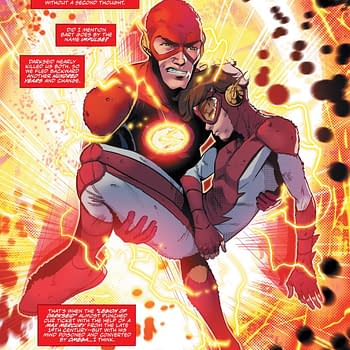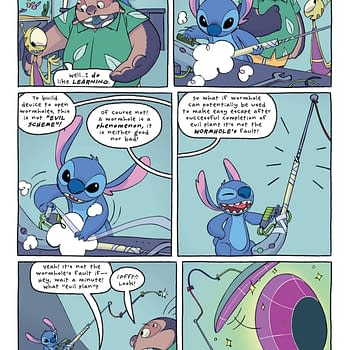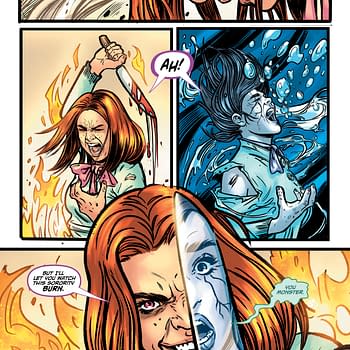Posted in: Comics, Recent Updates | Tagged: Dan Jackson, david lapham, Mike Huddleston
Review: Guillermo Del Toro & Chuck Hogan's The Strain Volume 1 by David Lapham, Mike Huddleston, Dan Jackson and Clem Robbins
Alasdair Stuart writes for Bleeding Cool
Story by Guillermo Del Toro and Chuck Hogan
Script by David Lapham
Art by Mike Huddleston
Colours by Dan Jackson
Letters by Clem Robbins
Cover art by E.M. Gist
Chapter Art by Mike Huddleston and E.m. Gist
Published by Dark Horse
£14.99
Twilight is the best thing to happen to vampire fiction in ten years and I can prove it with an etch-a-sketch, 4 dozen jammy dodgers, a Fez and copies of The Strain and Justin Cronin's The Passage. The need to set something up on the other side of the critical seesaw to Twilight has meant that Cronin's book got huge commercial traction and equally huge critical acclaim whilst The Strain, a project that had previously been shopped around the TV networks and passed on, is now in development with FX. Like the sparkly little buggers or loathe them, at least some of the credit for that has to go to the Cullens. But only some.
Whilst we wait for the FX show, Dark Horse have begun adapting Guillermo Del Toro and Chuck Hogan's novels and this week saw the release of the first collection. It's a chunky tome too, and the quality not only of the source material but the creative team on the book is apparent from the first page. Here are some of the things I particularly liked:

The opening, with a multi-agency task force called to a 747 which has landed and isn't responding to calls, is one that fans of superlative, and in its last season flat out manically brilliant, science fiction show Fringe will find familiar. Del Toro has mentioned this, saying that the two were developed separately and the parallel doesn't hurt either property. The image of a colossal haunted house of the sky, squatting at the end of the runway is as redolent with threat on paper as it was on the screen.

Huddleston and Jackson are turning in career-best work here and the sequence with the team searching the plane, full of people who have apparently died peacefully in their sleep, all at once, is chilling. Look at the tones here, the circles of light which barely extend back down the cabin. The cabin itself is skewed perspective, simultaneously cramped and cavernous and there's a sense of something waiting, something predatory to the areas outside the shadows. The page drips with threat, and it's only the first of many.
3.Just A Little Girl
This is one of the panels that Huddleston and Jackson really cut loose on. The shadows around the eyes, the pallid skin, the deep, clot red in the eyes and around the mouth all scream predator, threat. It's perfectly placed too, a reveal at the end of a series of panels which explore the human cost of the tragedy and how little it matters in the great scheme of things. This isn't personal, it's just the food chain and the thing wearing Emma Gilbarton is most definitely at the top of the food chain.

Zack, the son of the book's hero, Doctor Ephraim Goodweather (I know, just go with it), is used to show how close to danger any and everyone is. This is part of the same series of scenes as the return of Emma Gilbarton to her home and the good Samaritan moment that puts Gusto in the same cell as Abraham Setrakian. It's the strongest part of a strong book, Jackson's deep, dark colors combining with Robbins' smart, relaxed lettering and Huddleston's keen eye for detail to create something extraordinary. Look at those three panels; the vampire turning, Zack instinctively cowering and the broken window, punctuated by his terrified breathing. Its visceral horror of a sort comics don't achieve often enough.

Abraham Setrakian, aging vampire hunter, is a gift of a role for whoever ends up being cast as him. Special attention must be paid to the amazing work that the entire team does on the flashback issue, exploring Setrakian's life pre and during his time in the Concentration Camps with an almost monochrome pallet and the sort of expressive, no holds barred detail that Huddleston excels at. It's a chilling issue, a season in hell similar to the 'Evey in prison' sequence in V For Vendetta and it all leads down to this; Abraham, Eph and Nora on the same page for the first time, the fearful, terrified vampire hunters trying to work out how to win a war they didn't know they were fighting. It lives in the blood. That's as good a start as any.

This book has some of the best character design I've ever seen. Not just the vampires either, fun as they are, but the characters themselves. People are short, tall, skinny, fat, bald and long haired and everything in between. There's no airbrushing, no improbably group of supermodel scientists standing between us and Armageddon, just a small group of terrified, human people led by an old man who's been to hell and back and looks like this. The vampires may be on the front cover but in design terms the humans are the stars.

I didn't like this scene in the novel either and there are two reasons why, which the graphic novel neatly accentuates. The 'evil' neighbour is a stereotype in the novel but here he's a full-bore Mr Wilson-a-like. Similarly, the novel sees Ansel's wife Ann-Marie lock the door and bolt for the house. By going down the tearful prayer route, both she and Ansel are weakened as characters, becoming Ozzy and Harriet-like figures whose religion is a crutch that will give beneath them at any moment. It's the one slack moment in the book, the one point where characters are defined by actions rather than the other way around and it sticks out a mile. Stereotypical, unnecessary and for me it damages the scene a little. It's still horrific, still hugely uncomfortable to sit through but it could, and should, have been more.
8.Action Scientists
The climactic fight in this volume sees Eph, Nora and Abraham kill Emma Gilbarton and her turned father. It's a short, brutal engagement and this panel neatly embodies what's really going on. Abraham has an army now, just like Sardu, the ancient vampire he's seeking. His is smaller, more fragile but it's tenacious, brutal and smart. Animals vs scientists, hunters vs smaller, weaker, clever prey. It's not going to be an easy fight, for either side, and the sight of Abraham, Eph and Nora fighting side by side, as equals, drives home that home.
The Strain is, the tiny bum note of the shed scene aside, as close to a perfect adaptation as you'll get. The characters that've been excised, whilst fun, were outside the central orbit of Eph, Abraham and Nora and changes all work to strengthen the book immensely. In fact, the central themes; the two old generals raising their armies one last time, the vampires as family and tribe compared to the shattered, lone individuals of humanity and the sheer horror of seeing a city infected with death itself are all to the fore here and all given room to breathe and grow. If you're a fan of the books you'll find a lot to enjoy playing spot the difference and if you've never tried them before this is the perfect starting point. Not quite a classic, but still essential reading.
The Strain is available from Dark Horse now, priced £14.99













